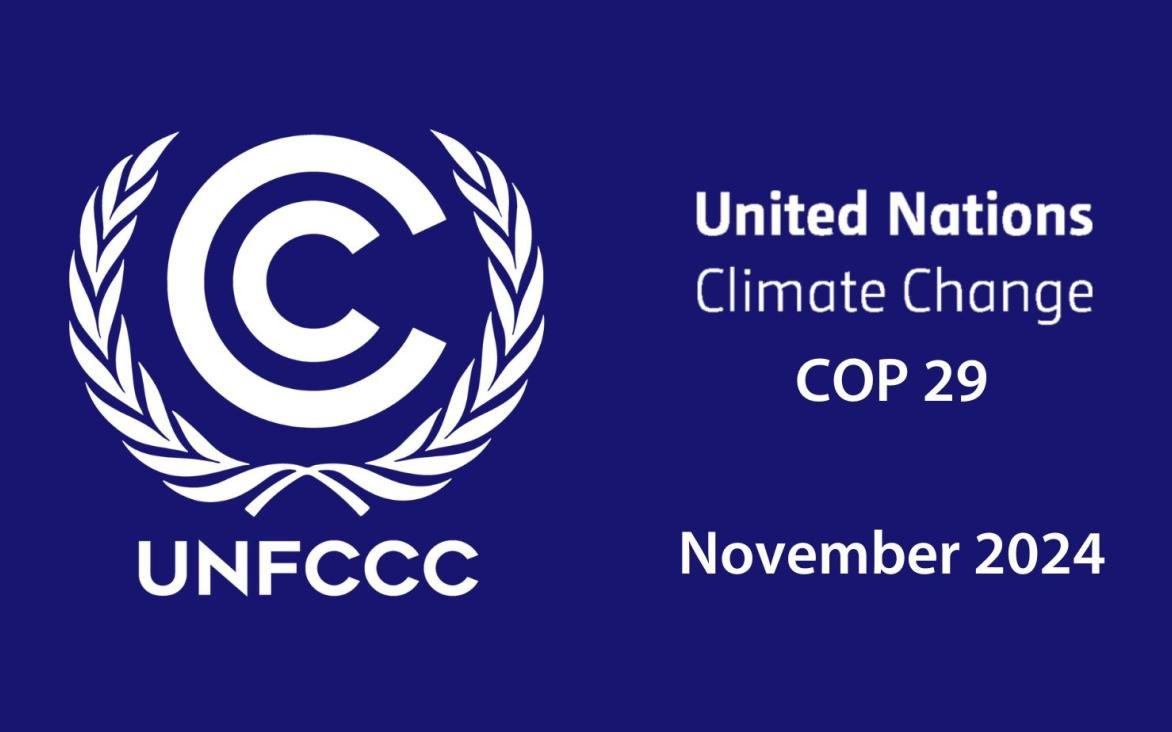

Introduction to COP:
The COP29 stands for the 29th Conference of the Parties to the United Nations Framework Convention on Climate Change (UNFCCC). COP29 consisting of representatives from all UNFCCC ratifying nations, is the highest decision-making body of the Convention. Established in 1992, the UNFCCC commits these nations to stabilize greenhouse gas levels to prevent dangerous climate interference. The COP convenes annually unless otherwise decided by the Parties. Inaugural meeting of the COP took place in Berlin, Germany, in March 1995.
The COP reviews the implementation of the Convention and its legal instruments, making decisions to ensure their effective execution. It evaluates national communications and emission inventories from Parties to assess their actions’ impact and progress toward the Convention’s goals.
Key Outcomes of COP27 and COP28:
A major outcome of COP27 was the creation of a “Loss and Damage” fund to support vulnerable countries facing the adverse impacts of climate change, such as extreme weather and rising sea levels. This marks a significant victory for developing nations that have long sought such financial assistance.
A key outcome of COP28 was the conclusion of the first-ever Global Stocktake (GST), a mid-term review of progress toward the 2015 Paris Agreement. The conference underscored the need for a firm action to advance renewable energy, promote a just transition, and accelerate overall climate efforts.
Looking Ahead: COP29 in Baku, Azerbaijan
COP29 is the 29th Conference of the Parties to the United Nations Framework Convention on Climate Change (UNFCCC) and will be held in Baku, Azerbaijan. It’s an annual international conference where countries would gather to discuss and negotiate actions to address climate change. The vision of COP29 is built on two main pillars: increasing ambition and facilitating action.
The priority of COP29 Presidency is to negotiate a fair and ambitious climate finance goal, known as the New Collective Quantified Goal (NCQG) which aims to address the urgent and large-scale climate challenges while considering the needs and priorities of developing countries. COP29 Presidency welcomed the OECD’s report that developed countries raised $115.9 billion in 2022. They urge continued efforts to meet the $100 billion goal by 2025 with more clarity and transparency.
The COP29 Presidency has also prioritized the completion of the operational framework for Article 6 of the Paris Agreement this year. Article 6 establishes both market-based and non-market-based mechanisms to facilitate international cooperation in reducing greenhouse gas emissions that allows countries to collaborate more effectively in meeting their climate goals.
COP29 welcomes the G7’s commitment to climate action which includes G7’s pledge to submit Nationally Determined Contributions (NDCs) aligned with the 1.5-degree Celsius target, phase out existing unabated coal power generation by the early 2030s, contributing to the new global climate finance goal. COP29 stresses the urgent need for sustained and enhanced contributions to climate finance mechanisms, such as the Green Climate Fund and the Adaptation Fund. They are actively collaborating with these funds to enhance effectiveness in delivering adaptation finance. Additionally, they are advocating for the Green Climate Fund to accelerate its support for the development and implementation of National Adaptation Plans (NAPs).
India’s Perspective on COP29: Priorities, Challenges, and Expectations
The European Union’s introduction of the Carbon Border Adjustment Mechanism (CBAM), designed to tax the carbon content of imports, carries significant implications for India, a major exporter to the EU. Starting January 1, 2026, the EU plans to impose a carbon tax on each consignment of steel and aluminium, with potential tariffs that are ranging between 20% – 35%. This will impact approximately 0.05% of India’s GDP, prompting India to carefully consider its response.
In this context, India’s approach to COP29 will likely focus on several strategic priorities and responses to the evolving global climate policy landscape. India may advocate for international consultations to establish carbon standards and regulations that are fair, transparent, and do not hinder the economic development of emerging economies.
At COP29, India is expected to reaffirm its position that developed countries, which have historically been the largest contributors to greenhouse gas emissions, should bear a greater share of the responsibility in addressing climate change. The commitment of $100 billion per year in climate finance, first agreed upon at COP15 in Copenhagen and reiterated in subsequent COPs, remains unmet. India is anticipated to demand clarity on the disbursement of these funds and advocate for more accessible financing for developing nations.
India intends to seek enhanced international cooperation and investment in its renewable energy sector. Key themes in India’s COP29 strategy are expected to include initiatives such as afforestation, reforestation, sustainable agriculture, and the conservation of water bodies.
India’s stance at COP29 will likely stress the need to balance ambitious climate action with economic growth and poverty reduction. India has committed to its own Nationally Determined Contributions (NDCs) under the Paris Agreement, which include reducing the emissions intensity of its GDP and increasing the share of non-fossil fuel-based energy in its energy mix.
Conclusion:
India’s approach to COP29 is expected to focus on safeguarding its economic interests while making significant contributions to global climate efforts. Given the implications of the EU’s carbon tax and other similar policies, India is set to push for equitable trade practices, increased climate finance, improved technology transfer, and climate justice.
As global discussions balance climate action with economic growth, India’s position at COP29 will play a pivotal role in influencing the direction of international climate negotiations.

